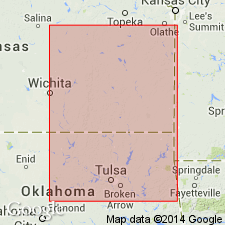
- Usage in publication:
-
- Burlington limestone
- Modifications:
-
- Original reference
- Dominant lithology:
-
- Limestone
- Shale
- AAPG geologic province:
-
- Forest City basin
Summary:
Pg. 110, 120-121, 125. Burlington limestone or Garnett limestone. Hard, compact limestones separated into two parts by 8 to 10 feet of shale. Here called Burlington or Garnett limestone, ultimate choice of name being left to future. Overlies Le Roy shales. Separated from overlying Strawn limestone by 75 to 100 feet of shale. [Age is Pennsylvanian.]
Named from Burlington, Coffey Co., eastern KS.
Source: US geologic names lexicon (USGS Bull. 896, p. 299)

- Usage in publication:
-
- Burlington limestone†
- Modifications:
-
- Abandoned
- AAPG geologic province:
-
- Forest City basin
Summary:
†Burlington limestone abandoned. Same as Oread limestone, according to R.C. Moore, 1936 (Kansas Geol. Survey Bull., no. 22).
Source: US geologic names lexicon (USGS Bull. 896, p. 299).
For more information, please contact Nancy Stamm, Geologic Names Committee Secretary.
Asterisk (*) indicates published by U.S. Geological Survey authors.
"No current usage" (†) implies that a name has been abandoned or has fallen into disuse. Former usage and, if known, replacement name given in parentheses ( ).
Slash (/) indicates name conflicts with nomenclatural guidelines (CSN, 1933; ACSN, 1961, 1970; NACSN, 1983, 2005, 2021). May be explained within brackets ([ ]).

